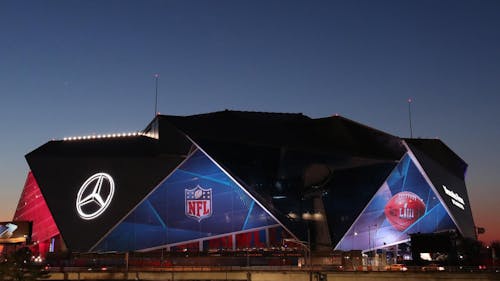The Super Bowl highlights huge sporting events' dangerous impact on American consumerism

American culture allows consumerism to thrive, giving huge companies ample time in the spotlight — and no cultural cornerstone represents these commitments to consumerism more than the Super Bowl.
As the annual championship game of the National Football League (NFL), it serves as a representation of what Americans value most and influences the world’s perception of us. By feeding off its own reputation and historical significance, football never needs to innovate or represent anything greater than itself.
With athletes like Colin Kaepernick challenging the status quo and being ousted from the spotlight due to it, the commitment to keeping players in line highlights football’s whitewashed roots, as well as the fact that it emulates corporate culture — just repackaged to relate to its middle-class audience.
Advertisers sell the illusion of control to their audience, but their sole priority is always making money and saving time. The more eyes that watch their advertisement, the more money the investors, shareholders and football owners gain.
With how normalized forgetting about the pandemic in favor of profit is, it’s socially acceptable to hold potential superspreader events like the Super Bowl. This is no surprise as the U.S. has long prioritized economic interests over the welfare of its citizens.
While the game was officially between the Cincinnati Bengals and the Los Angeles Rams, the real star of the game is cryptocurrency.
This year’s Super Bowl has been dubbed the “Crypto Bowl” based on the number of crypto advertisements that will be broadcasted during the game. Crypto companies are paying millions of dollars for a minute of advertisers’ time, which not only highlights the competitive nature of advertising during the Super Bowl, but may also increase crypto’s appeal to the mainstream.
Executives believe the Super Bowl is a prime opportunity to introduce the average American to digital currency, even while many of crypto’s founders have been racked by controversy with the rise of crypto scams.
While they're touted as geniuses, their inventions are often undone by their hubris. Despite this, interest in cryptocurrency has skyrocketed due to the popularity of non-fungible tokens, aka NFTs, and the creation of the blockchain.
The cost of an advertisement for a Super Bowl is notorious for being ridiculously expensive, with companies paying millions of dollars for a 30-second or 1-minute slot. Even though fewer people ages 18-49 are watching — which is a target demographic for network executives and advertisers — Super Bowl advertisements are still basically an industry of their own.
The genius of the Super Bowl is that it brings together key aspects of American culture and consolidates their interests for a unified cause. Despite the repetitive aspects of mainstream American television, Americans will spend at least 14.6 billion dollars on Super Bowl-related purchases in 2022.
Traditional American values also align with the patriotism present in the Super Bowl. The national anthem is always performed at the game and military celebrations feel quintessentially American.
Football’s audience and player base are also overwhelmingly white, and as a sport, it represents an antiquated ideal of white masculinity. While this year’s halftime show included performances from Dr. Dre and Mary J. Blige, this is a business decision and in no way shows a shift in politics that the NFL has historically held.
At the end of the day, the Super Bowl is a football game. While a football game is 3 hours in length, only 18 minutes are spent with the ball actually in play. The rest of the game is led by timeouts, commercials, injuries and commentary. This ratio means that approximately 90 percent of an NFL game is without live player action, which concentrates the same sense of filler-fueled delusion that entertaining television provides.
The Super Bowl represents America’s obsession with consumerism and emphasizes that having your time bought and sold now works as a well-oiled machine instead of a concept that the population actively rebels against.
Advertisers control the narrative of our lives and influence what we consume and know — and this year’s Super Bowl represents how trends hold a fierce grip on American society and highlight our collective national narcissism.



